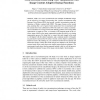Free Online Productivity Tools
i2Speak
i2Symbol
i2OCR
iTex2Img
iWeb2Print
iWeb2Shot
i2Type
iPdf2Split
iPdf2Merge
i2Bopomofo
i2Arabic
i2Style
i2Image
i2PDF
iLatex2Rtf
Sci2ools
ACIVS
2008
Springer
2008
Springer
Scene Reconstruction Using MRF Optimization with Image Content Adaptive Energy Functions
Multi-view scene reconstruction from multiple uncalibrated images can be solved by two stages of processing: first, a sparse reconstruction using Structure From Motion (SFM), and second, a surface reconstruction using optimization of Markov random field (MRF). This paper focuses on the second step, assuming that a set of sparse feature points have been reconstructed and the cameras have been calibrated by SFM. The multi-view surface reconstruction is formulated as an image-based multi-labeling problem solved using MRF optimization via graph cut. First, we construct a 2D triangular mesh on the reference image, based on the image segmentation results provided by an existing segmentation process. By doing this, we expect that each triangle in the mesh is well aligned with the object boundaries, and a minimum number of triangles are generated to represent the 3D surface. Second, various objective and heuristic depth cues such as the slanting cue, are combined to define the local penalty...
ACIVS 2008 | Computer Vision | Multi-view Scene Reconstruction | Multi-view Surface Reconstruction | Surface Reconstruction |
| Added | 01 Jun 2010 |
| Updated | 01 Jun 2010 |
| Type | Conference |
| Year | 2008 |
| Where | ACIVS |
| Authors | Ping Li, Rene Klein Gunnewiek, Peter H. N. de With |
Comments (0)

